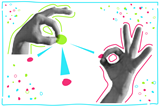Evidence-informed tips to help you support student sensemaking with effective classroom conversations

Navigating the observational, symbolic and theoretical knowledge domains is vital if students are to make sense of chemistry, but this represents a significant challenge. Sensemaking is a dynamic process. This involves creating an explanation using the iterative processes of construction and critique, as well as connecting prior knowledge and lived experience. This includes working something out, integrating knowledge, connecting representations and using discussion to build and evaluate an explanation.
Students often particularly struggle to connect theory to observable phenomenons, so we need to actively support them in connecting concepts to what they learn in practical work. We need to use targeted dialogue to help students successfully navigate the macroscopic (observable), submicroscopic (particulate) and symbolic domains.
If students perceive teacher support, they will be more engaged in sharing ideas and posing questions – the building blocks of sensemaking. When we label contributions as incorrect, this can cause tension in the classroom and lead to students becoming guarded in their contributions, stifling discussion. Another factor is the complex language we use to talk about chemistry. When students often use everyday language to communicate ideas in lessons, we must be aware of and sensitive to this challenge.
A study by Ylva Hamnell-Pamment explored how teachers supported student sensemaking in the study of equilibrium through classroom conversations. Part of the rationale for exploring this topic was that students learn at an early stage that chemical reactions are irreversible and the perception of a static, rather than a dynamic, reaction state can persist even to university level.
The study involved 64 students from four classes in different schools, with a small majority graded at higher achievement levels. Four lessons, with a similar structure, were videoed and audio recorded. Each involved an introduction by the teacher, followed by a class practical during which students discussed their answers to questions on a practical sheet. Over five hours of video were collected and analysed using conversation analysis.
Teaching tips
- Maintain a positive learning environment. Complex concepts can be difficult for students, so it’s important to find the balance between a student’s need to express their own reasoning and your need to ensure they are correct. Incorrect answers can provide a basis for further elaboration.
- Display the equilibrium equation and add particle diagrams while prompting students to think about the interplay between concentration and reaction rate. This can boost their understanding of the basis of equilibrium shifts. Make such particulate-level explanations a norm in classroom discourse to support sensemaking.
- Concept mapping is a valuable tool to get students to formulate links between concepts and articulate their sensemaking.
- Use the supplementary materials that accompany this study for a class practical to replace the usual teacher demonstration.
The level of transcript analysis was extremely detailed, identifying nuances implied in intonation and non-verbal actions. One theme that popped up in all conversations was the connection of observations to theory, exemplified by the connection of the colour change of a reaction mixture to the chemical equation. Similarly, when discussing the addition of a solution to an equilibrium, students linked it to a proposed reaction.
Another prevalent theme that cropped up was managing tension. Teachers in the study managed tension in several ways, including linking a discussion to alternative concepts – by asking a student to think about concentration when they didn’t know the answer, for example – as well as by gesturing towards the answer to give students a clue.
Mapping out sensemaking
In a related study, Ylva explored the role of concept mapping in judging how accurately students use language to make sense of equilibrium. The study used a focus question: How can we describe and explain a reaction involving chemical equilibrium? It had three knowledge domains at the top of the map: empirical/macroscopic, communicative/symbolic and theoretical explanations.
The map had five starting concepts: K, ⇌, colour change, concentration and reversible. The study analysed the concept maps of 88 students and only 14 were fully structured in their use of the three domains.
Where sensemaking between domains was lacking, concept maps were either linear in nature, suggesting that students were using damaging rote learning, or branched, indicative of superficial or learning which is not reflective. Interestingly, high-attaining students did not necessarily generate well-structured concept maps, which may suggest they relied on memorisation.
Reference
Y Hamnell-Pamment, Chem. Educ. Res. Pract., 2024, https://doi.org/10.1039/d3rp00249g
David Read
References
Y Hamnell-Pamment, Chem. Educ. Res. Pract., 2024, doi.org/10.1039/d3rp00249g














No comments yet